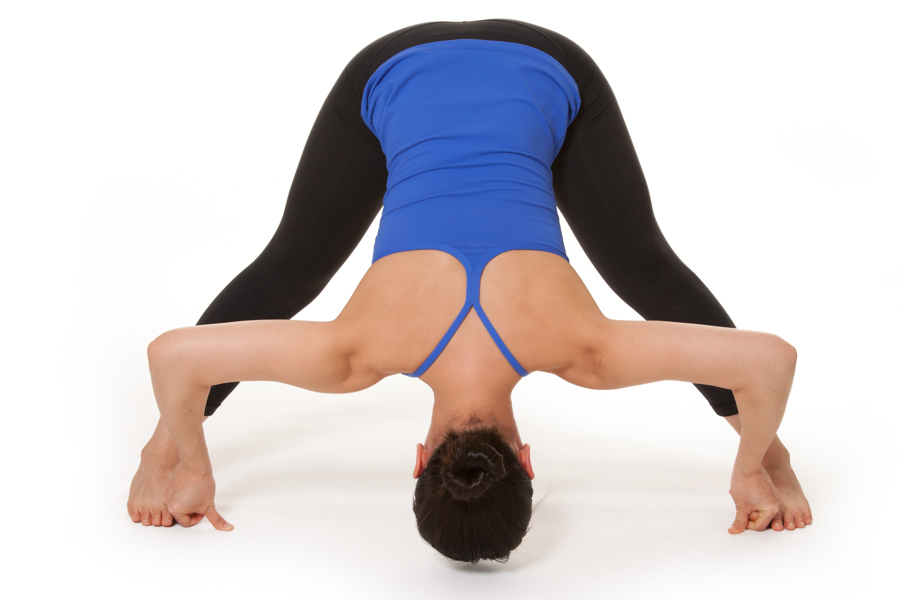Standing Wide Leg Forward Bend II (Prasarita Padottanasana II)
- At March 14, 2020
- By Daniel
- In Asana, Yoga Benefits
 0
0
 All Standing Forward Bends improves and maintains leg and back flexibility. For some people, wide leg forward bends put less stress on their backs and legs than straight leg forward bends. All forward bends provide the same physical and mental health benefits.
All Standing Forward Bends improves and maintains leg and back flexibility. For some people, wide leg forward bends put less stress on their backs and legs than straight leg forward bends. All forward bends provide the same physical and mental health benefits.
Use caution if you have glaucoma or a family history of high blood pressure. A research study found yoga poses where the head is lower than the heart may increase eye pressure. One way to reduce the risk is by limiting your time in these poses.
English Name: Standing Wide Leg Forward Bend II
Sanskrit Name: Prasarita Padottanasana II
Difficulty Level: 4
Start Position: Mountain
Instructions:
Step 1.
Step or jump your feet about 3 feet apart or a comfortable distance keeping your feet parallel to each other.
Step 2.
Bend (fold) forward from your hips maintaining a straight back and tilting your sit bones upward.
Step 3.
Curl the first two fingers on each hand around your big toes. If possible, rest the crown of your head on the floor.
Step 4.
Remain in the pose as long as it feels comfortable. Return to Mountain pose.
Physical Benefits:
- Improves and maintains ankle, knee, thigh and low back strength
- Tones abdomen
- Stretches wrists, arms, hamstrings, calves
- Reduces minor back pain or discomfort
- Lowers blood pressure
- Reduce headache pain
- Open sinuses
- Improves digestions
Mental Benefits
- Reduces stress
- Improves thinking
- Increases focus
- Relieves mild anxiety & depression
Contraindications:
- Low back or wrist injury
- High Blood Pressure
- Glaucoma
Mountain Pose (Tadasana)
- At March 10, 2020
- By Daniel
- In Asana, Yoga Benefits
 0
0
 Mountain Pose is the start position for many standing poses and salutations like the Sun Salutation. Like Staff pose, it looks Mountain pose is a simple, straight forward pose. Mountain pose is about balance and focus. Place more weight on leg verses the other and you can loose your balance and topple over. The legs and spine are straight. The knees should not be bent. The arms are straight, not bent at the elbow or wrist. The head and neck are straight, not tilted to one side or front to back. While Mountain pose has a difficulty level of 1 out of 10, there is more to the pose than meets the eye.
Mountain Pose is the start position for many standing poses and salutations like the Sun Salutation. Like Staff pose, it looks Mountain pose is a simple, straight forward pose. Mountain pose is about balance and focus. Place more weight on leg verses the other and you can loose your balance and topple over. The legs and spine are straight. The knees should not be bent. The arms are straight, not bent at the elbow or wrist. The head and neck are straight, not tilted to one side or front to back. While Mountain pose has a difficulty level of 1 out of 10, there is more to the pose than meets the eye.
English Name: Mountain
Sanskrit Name: Tadasana
Difficulty Level: 1
Start Position: Standing Erect
Instructions:
Step 1. Stand with feet hip-width apart. Relax your shoulders and relax your arms along side your body.
Physical Benefits
- Aligns spine
- Opens the chest
- Improves posture
- Strengthens ankles
- Strengthens knees
- Strengthens thighs
- Strengthens arches
Mental Benefits
- Improved focus
- Reduces mild anxiety
Contraindications
- Wrist injury
- Knee or ankle pain




